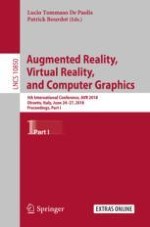
2018 | OriginalPaper | Buchkapitel
Sense of Presence and Cybersickness While Cycling in Virtual Environments: Their Contribution to Subjective Experience
verfasst von : Marta Mondellini, Sara Arlati, Luca Greci, Giancarlo Ferrigno, Marco Sacco
Erschienen in: Augmented Reality, Virtual Reality, and Computer Graphics
Aktivieren Sie unsere intelligente Suche, um passende Fachinhalte oder Patente zu finden.
Wählen Sie Textabschnitte aus um mit Künstlicher Intelligenz passenden Patente zu finden. powered by
Markieren Sie Textabschnitte, um KI-gestützt weitere passende Inhalte zu finden. powered by